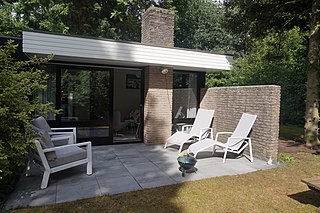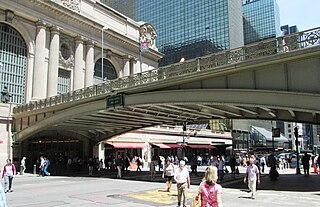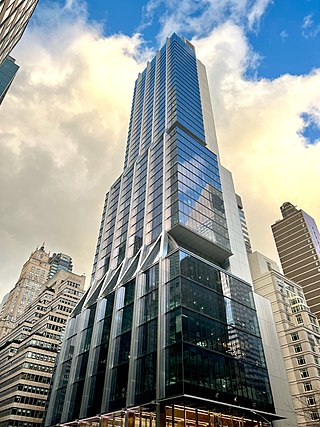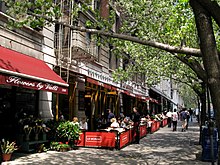
Zoning is a method of urban planning in which a municipality or other tier of government divides land into areas called zones, each of which has a set of regulations for new development that differs from other zones. Zones may be defined for a single use, they may combine several compatible activities by use, or in the case of form-based zoning, the differing regulations may govern the density, size and shape of allowed buildings whatever their use. The planning rules for each zone determine whether planning permission for a given development may be granted. Zoning may specify a variety of outright and conditional uses of land. It may indicate the size and dimensions of lots that land may be subdivided into, or the form and scale of buildings. These guidelines are set in order to guide urban growth and development.

A patio is an outdoor space generally used for dining or recreation that adjoins a structure and is typically paved. In Australia the term is expanded to include roofed structures such as a veranda, which provides protection from sun and rain.

Gus's cafe is a cafe located in Civic, Canberra, Australia. It opened in 1969 and later became the first outdoor pavement cafe in Canberra. It is one of the oldest and best known cafes in Canberra and one of the first European-style cafes in Australia. It has both outdoor and indoor dining areas.

A setback, in the specific sense of a step-back, is a step-like form of a wall or other building frontage, also termed a recession or recessed storey. Importantly, one or more step-backs lowers the building's center of mass, making it more stable. A setback as a minimum one-bay indent across all storeys is called a recessed bay or recess and is the more common exterior form of an alcove (architecture).

The Death and Life of Great American Cities is a 1961 book by writer and activist Jane Jacobs. The book is a critique of 1950s urban planning policy, which it holds responsible for the decline of many city neighborhoods in the United States. The book is Jacobs' best-known and most influential work.

Mixed use is a type of urban development, urban design, urban planning and/or a zoning classification that blends multiple uses, such as residential, commercial, cultural, institutional, or entertainment, into one space, where those functions are to some degree physically and functionally integrated, and that provides pedestrian connections. Mixed-use development may be applied to a single building, a block or neighborhood, or in zoning policy across an entire city or other administrative unit. These projects may be completed by a private developer, (quasi-) governmental agency, or a combination thereof. A mixed-use development may be a new construction, reuse of an existing building or brownfield site, or a combination.

New York City's Theater District, sometimes spelled Theatre District and officially zoned as the "Theater Subdistrict", is an area and neighborhood in Midtown Manhattan where most Broadway theaters are located, in addition to other theaters, movie theaters, restaurants, hotels, and other places of entertainment. It is bounded by West 40th Street on the south, West 54th Street on the north, Sixth Avenue on the east and Eighth Avenue on the west, and includes Times Square. The Great White Way is the name given to the section of Broadway which runs through the Theater District.

Café Brauer is a restaurant building and official landmark located in Lincoln Park in Chicago, Illinois, at the edge of the Lincoln Park Zoo. It was designed by Dwight H. Perkins and completed in 1908.
The Studebaker Building is a former structure at 1600 Broadway on the northeast corner at 48th Street in Manhattan, New York City. It was erected by the Juilliard Estate, in 1902, between Broadway and 7th Avenue, in the area north of Times Square. It was demolished in 2004 to make room for an apartment tower, a twenty- five story, 136 unit, luxury condominium designed by architect Einhorn Yaffee Prescott.

Washington Harbour is a Class-A mixed-use development located at 3000 and 3050 K Street, N.W., in Washington, D.C., in the United States. The southern edge of the development borders the Potomac River on the Georgetown waterfront. Designed by Arthur Cotton Moore, the complex consists of two curved towers and three other buildings attached to them, all of which are in the Postmodern architectural style. The complex contains luxury condominia, offices, retail space, restaurants, and underground parking.

Outdoor dining, also known as al frescodining or dining alfresco, is eating outside.

Pershing Square is a public plaza in Manhattan, New York City, located where Park Avenue and 42nd Street intersect in front of Grand Central Terminal. The main roadway of Park Avenue crosses over 42nd Street on the Park Avenue Viaduct, also known as the Pershing Square Viaduct. Two service roads, one northbound and one southbound, connect 42nd Street with the main roadway of Park Avenue, at 40th Street.

Argyle Street is located in downtown Halifax, Nova Scotia, Canada. It is approximately 460 metres long and stretches four city blocks to the west of, and parallel to, Barrington Street from Duke Street to Blowers Street. The street is a popular centre for live music, nightlife, theatre, and al fresco dining.

425 Park Avenue is an office building in New York City redeveloped by L&L Holding and GreenOak Real Estate, with a design by architectural firm Foster + Partners. Work on the new structure began in 2016, and the building was completed in October 2022.

The COVID-19 pandemic affects the global food industry as governments close down restaurants and bars to slow the spread of the virus. Across the world, restaurants' daily traffic dropped precipitously compared to the same period in 2019. Closures of restaurants caused a ripple effect among related industries such as food production, liquor, wine, and beer production, food and beverage shipping, fishing, and farming.

Carbone is an Italian restaurant chain with locations in the Greenwich Village neighborhood of Manhattan and elsewhere. It is operated by Major Food Group, which also operates ZZ's Clam Bar. The original restaurant opened in 2013, and replaced another Italian establishment, the 90-year-old Rocco Restaurant. Founders Mario Carbone and Rich Torrisi say that they modeled the menu, decor, and atmosphere on mid-century Italian restaurants popular in New York City.
The COVID-19 pandemic in Toronto is an ongoing viral pandemic of coronavirus disease 2019 (COVID-19), a novel infectious disease caused by severe acute respiratory syndrome coronavirus 2 (SARS-CoV-2). Toronto is the most populous city in Canada, and the fourth most populous city in North America.

Papi Chulo's is a restaurant in the Pearl District of Portland, Oregon, in the United States. The taqueria was opened by restaurateur Ramzy Hattar in December 2019, with Antonio Javier Palma Caceres as the chef and Davide Bricca overseeing cocktails. The trio had previously worked together at River Pig Saloon and Two Wrongs, two neighboring establishments also owned by Hattar. Papi Chulo's serves Mexican cuisine, such as tacos, burritos, nachos, birria, margaritas, and micheladas. The business continued to operate delivery and takeout services during the COVID-19 pandemic, and in November 2020 confirmed plans to open a second restaurant in northeast Portland.

Bridges Cafe & Catering was a restaurant and catering service in Portland, Oregon. Established in 1994, the cafe was later purchased by Tom and Laura Lane-Ruckman, who continued to operate the business until the economic impact of the COVID-19 pandemic forced a closure in November 2020. The restaurant served Southern and Tex-Mex cuisine and had earned more than half of its revenue from catering. Considered a neighborhood favorite, the interior featured a small dining room, mosaic tiled tables, and artworks by various artists on the walls depicting bridges. The cafe was most known for its grits, its longtime server called "Phreddie", and for supporting local groups.

Jam on Hawthorne is a restaurant in Portland, Oregon.




















